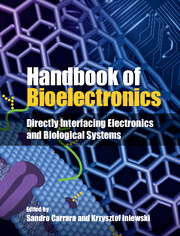Book contents
- Frontmatter
- Contents
- List of Contributors
- 1 What is bioelectronics?
- Part I Electronic components
- Part II Biosensors
- 8 Introduction to biosensors
- 9 CNT and proteins for bioelectronics in personalized medicine
- 10 CMOS nanowire biosensing systems
- 11 Cell-array biosensors
- 12 System-on-a-chip pulse radar for contactless motion sensing in human–machine smart interfaces
- 13 MagCMOS
- 14 Metamorphic neural interfaces with insects for remote controlled biobots
- Part III Fuel cells
- Part IV Biomimetic systems
- Part V Bionics
- Part VI Brain interfaces
- Part VII Lab-on-a-chip
- Part VIII Future perspectives
- Index
- References
14 - Metamorphic neural interfaces with insects for remote controlledbiobots
from Part II - Biosensors
Published online by Cambridge University Press: 05 September 2015
- Frontmatter
- Contents
- List of Contributors
- 1 What is bioelectronics?
- Part I Electronic components
- Part II Biosensors
- 8 Introduction to biosensors
- 9 CNT and proteins for bioelectronics in personalized medicine
- 10 CMOS nanowire biosensing systems
- 11 Cell-array biosensors
- 12 System-on-a-chip pulse radar for contactless motion sensing in human–machine smart interfaces
- 13 MagCMOS
- 14 Metamorphic neural interfaces with insects for remote controlled biobots
- Part III Fuel cells
- Part IV Biomimetic systems
- Part V Bionics
- Part VI Brain interfaces
- Part VII Lab-on-a-chip
- Part VIII Future perspectives
- Index
- References
Summary
Muscles are the mechanical actuators of the body controlled by neurons. Weuse these actuators to perform many actions during the activities of ourdaily life. Moreover, we have benefited throughout history from the musclepower of larger animals, for farming, transportation, and industry. However,the muscle power of insects has not yet been exploited reliably orreproducibly, although insects possess a much higher ratio of muscle forceto body mass than most large domesticated mammals. The novel field ofinsect–machine interfaces (IMI) combines microtechnology andneuroengineering to benefit from the muscle power of insects in a“biobotic” manner. To facilitate this, Early MetamorphosisInsertion Technology (EMIT) provides a novel neurotechnological pathway forintegrating microelectronic sensing and actuation platforms into insectsduring metamorphosis. Metamorphic development not only provides an elegantand effective method of mechanically affixing artificial systems in or on aninsect, but also produces a reliable bioelectrical interface without anyobservable short-term adverse effect on insect flight behavior. As anapplication of biobotic control of insect locomotion, the first stepstowards flight and gait navigation in moths and cockroaches are presented inthis chapter.
Insect–machine interfaces (IMI)
Developments in micromachining technology have shifted the notion ofimplantable neuromotor prosthetics from science fiction to reality [1]. Thehighly miniaturized complementary metal oxide semiconductor (CMOS)electronics on these micromachined probes have made possible a number ofcomplicated neurophysiological studies by coupling state-of-the-art signalprocessing technologies to initiate and record advanced brain function [2,3]. This technology provides techniques and tools that allow us tounderstand and generate robust electronically controlled muscle movement.Restoring impaired motor function has been possible in vertebrates such asrabbits, cats, and monkeys, and will eventually be useful for humans, bycontrolling their motor function using either external operator commands orthe output of the subject’s own brain [4, 5]. These systems are at asuitable scale (~5 mm3) to fit on an insect to buildinsect–machine interfaces (IMI). For a reliable IMI, hybridbioelectronic structures with insects need to be formed through which CMOSdevices and micro-electromechanical systems (MEMS) structures are coupledwith the insect’s natural sensors and actuators.
Information
- Type
- Chapter
- Information
- Handbook of BioelectronicsDirectly Interfacing Electronics and Biological Systems, pp. 183 - 194Publisher: Cambridge University PressPrint publication year: 2015
